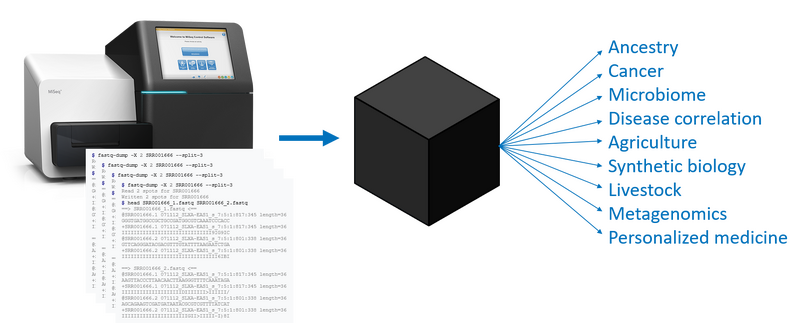About
Go back to BioCompute Objects.
What is BioCompute?
Tremendous insights can be found in genome data, and many of these insights are being used to drive personalized medicine. But the hundreds of millions of reads that come from a gene sequencer represent small, nearly random fragments of the genome that’s being sequenced, and there are countless ways in which that data can be transformed to yield insights into cancer, ancestry, microbiome dynamics, metagenomics, and many other areas of interest.
Because there are so many different platforms and so many different scripts and tools to analyze genome data, there is a great need to standardize the way in which these steps are communicated. The more analysis steps and the more complicated a pipeline, the greater the need for a standardized mechanism of communication. The BioCompute standard brings clarity to an analysis, making it clear and reproducible.
A BioCompute Object (BCO) is an instance of the BioCompute standard, and is a computational record of a bioinformatics pipeline. A BCO is not an analysis, but is a record of which analyses were executed and in exactly which ways. In this way, a BCO acts as an interface for existing standards. A BCO contains all of the necessary information to repeat an entire pipeline from FASTQ to result, and includes additional metadata to identify provenance and usage.
A BioCompute Object (BCO) is an instance of the BioCompute standard, and is a computational record of a bioinformatics pipeline. A BCO is not an analysis, but is a record of which analyses were executed and in exactly which ways. In this way, a BCO acts as an interface for existing standards. A BCO contains all of the necessary information to repeat an entire pipeline from FASTQ to result, and includes additional metadata to identify provenance and usage.
Our Mission
BioCompute is a standard for workflow communication. It comes with very strong data provenance, researcher attribution, and descriptive metadata features.
It is common to hear “x software was used” when reading about a computational pipeline. This is not enough to make informed scientific assessments of work, whether in academic publication reviews, regulatory decisions (e.g. at the FDA), internal process review (particularly for trade secrets), or in educational contexts. Poor workflow communication results in significant delays in reviews, or worse, outright rejection.
The BioCompute mission is to overhaul the way that computational analyses in biology are shared, understood, and reproduced between the research community, the clinical community, and regulatory organizations.
Our Story
BioCompute is built through collaboration between the George Washington University and the Food and Drug Administration (FDA) and approved as an official standard of IEEE 2791-2020. BioCompute brings transparency of the workflow and clear expectations for data sharing between communities. The project has worked with individuals from NIH, Harvard, several biotech and pharma companies, EMBL-EBI, Galaxy Project, and many more, and can be integrated with any existing standard for HTS data. Associate tools have been developed by popular bioinformatics platforms such as DNAnexus, Seven Bridges, and Galaxy for BCO submission with minimal effort. More information about The current BioCompute standard can be found on the Open Science Foundation website (where the standard is developed and maintained), the HIVE website, and the Research Objects discussion of BioCompute.
Our Audience
BioCompute serves a broad range of stakeholders within the scientific and biomedical research communities, including but not limited to:
- Researchers and Scientists
- Educators and Students
- Regulatory Bodies
- Bioinformatics and Data Analysts
- Software Developers and Engineers
Benefits of BioCompute Objects(BCOs)
- Enhanced Transparency: BCOs provide a clear and detailed account of documented computational analyses, ensuring all steps are visible and understandable.
- Improved Reproducibility: BCOs allow for documented analyses to be easily replicated to validate research findings.
- Streamlined Collaboration: BCOs facilitate better collaboration among researchers by providing a common framework for sharing workflows.
- Regulatory Compliance: BCOs support regulatory bodies in evaluating the validity and reliability of computational workflows, thereby enhancing the credibility of research.
- Educational Value: BCOs can make it easier for students and educators to grasp complected concepts and analyses much more easily through intuitive documentation.
Frequently Asked Questions
- What role does standardization play in scientific collaboration? Standardization, as provided by BCOs, is crucial for seamless collaboration across different institutions and disciplines, enabling researchers to build on each other’s work effectively.
- How can we improve reproducibility in Biomedical Research? Ensuring that research findings can be replicated by others is a cornerstone of scientific integrity. BCOs address this by providing a clear and detailed framework for documenting analyses.
- How can we ensure regulatory compliance in computational workflows? BCOs facilitate compliance by offering a transparent and consistent documentation method, helping regulatory bodies like the FDA evaluate computational analyses more efficiently.
WiFi Analogy
The 802.11 standard (more commonly called “WiFi”) is a way of standardizing communication between vastly different products on a wireless network. If a product manufacturer wants a product to be able to communicate on a wireless internet network, they can configure the device to use the WiFi standard and it will be able to communicate with most commercial routers, regardless of whether the product is a Mac, a PC, a cell phone, or a smart toaster.
BioCompute fills a similar need. BioCompute is not an automation or a new programming language, it is a way of collecting and communicating information between two entities. Rather than a latop and a router, it may be between a pharmaceutical company and the FDA, or between two clinicians, or between a clinician and a researcher. In much the same way that WiFi does not standardize the data that’s being transmitted – allowing you to use Apple’s Facetime, Microsoft’s Internet Explorer, or your favorite cell phone app – BioCompute does not standardize the platforms or tools that are used for genome analysis. You continue to use your favorite platforms and tools, whether it’s HIVE, Galaxy, Seven Bridges, DNAnexus, or others. Also like WiFi, BioCompute can be layered with other privacy or security protocols depending on usage. So clinical trial data can be secured and HIPAA-compliant, while government-funded data sets shared between researchers can be completely open access.
Because BioCompute acts like an envelope for an entire analysis pipeline, it is compatible with other existing standards, including FHIR Genomics and GA4GH.
BioCompute Description
BioCompute is written in Javascript Object Notation (JSON), which is simply a set of key:value pairs (meaning that raw files can be read without any knowledge of programming). Information within the BCO is organized into “domains.” The domains within a BCO record are Provenance, Usability, Extension, Description, Execution, Input/Output, and Parametric Domains. For more information on the domains, please see the BioCompute Schema.
BioCompute was built through a collaboration between The George Washington University and the FDA to improve communication of bioinformatics pipelines, and has since been expanded and refined through the participation or collaboration of hundreds of participants from throughout the public and private sectors. While we welcome interest and membership from anyone, most users will fall into one of three categories:
- Research Community
- The Biocompute standard can help substantially improve replicability, making it possible to repeat a pipeline on a different sample with high fidelity and high confidence.
- Clinical Community
- As BioCompute Objects become tested and validated, they can be applied in the clinic to identify risk factors, flag pharmakogenetic information, and much more.
- Pharma, Biotech and Regulatory Pipeline
- Protracted communications with the FDA can extend the review process by months. A standardized method of communicating HTS data may help repeat results more quickly and without the need for additional communication.
Research, clinical, and regulatory groups are key drivers of personalized medicine that is based on next generation sequencing, but there are barriers between these groups. BioCompute reduces these hurdles and brings transparency to the workflow, making it more clear what was done, and clearly delineating expectations for data sharing. The BioCompute specification can be layered with other privacy and security protocols to guard sensitive data, or be made open source depending on the needs of the user.
The BioCompute project has generated two publications, three workshops, FDA funding, contributions from over 300 participants, and FDA submissions. The project has worked with individuals from NIH, Harvard, several biotech and pharma companies, EMBL-EBI, Galaxy Project, and many more, and can be integrated with any existing standard for HTS data. The project is expected to be both an IEEE and ISO recognized standard within 8-10 months.
More information about The current BioCompute standard can be found on the Open Science Foundation website (where the standard is developed and maintained), the HIVE website, and the Research Objects discussion of BioCompute.


